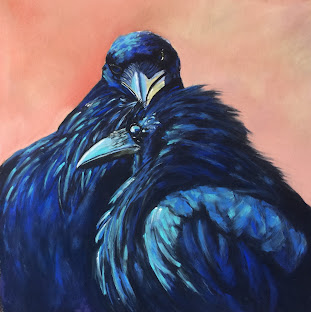My Artful Life
Original landscapes and birds in their natural surroundings
Wednesday, August 25, 2021
The Daily James
Saturday, August 21, 2021
Chicka-Dee-Dee-Dee
Saturday, August 14, 2021
On The Hunt
Saturday, August 7, 2021
The Wonderful World of Woodpeckers
Thursday, July 29, 2021
Cedar Waxwings and the Make-Up Artist
 |
| "Make Up Artist" Original in Soft Pastel 10 x 8 inches |
Cedar Waxwings get their name from the small red tips on the feathers of their inner wing, which reminded early naturalists of the red sealing wax used on important letters. The birds' red markings are not wax, of course, but keratin ( the same substance as the rest of the feather) formed into a solid flat tip and decorated with red pigment. Carotenoid compounds are common in fruits and seeds, and birds' bodies use these carotenoids to produce the range of red to yellow colors in their plumage.
Waxwings eat mainly fruit, and live an itinerant life, moving continuously through the winter. They spend most of the year in small flocks simply wandering in search of fruit. They will stay in an area only as long as the fruit lasts, then wander again in search of the next meal.
(From: What It's Like To Be A Bird by David Allen Sibley)
This painting is inspired by a flock of these beauties that wandered through our backyard eating the berries of our cypress tree... Waxwings are also known to gorge on pyracantha berries and become "drunk" . Scientists say that pyracantha berries contain hydrogen cyanide, which may act as a mild neurotoxin in birds if consumed in large amounts...
'Tis the season to be merry....
If you are interested in this painting, please visit my website:
Wednesday, July 21, 2021
Eastern Bluebird and the Color of Blue
Friday, November 13, 2020
Staying in the Joy
 |
| "Bath Time" |
What a time this is we find ourselves in. You think these birds playing in the bird bath know?
Hardly...
I'm a birdwatcher and a painter. I paint lots of birds. I sip coffee every morning and watch the birds compete for their turn at the bird feeder. In fact, since no one is coming to visit anytime soon, we decided to turn the matching conversations chairs towards the front window to look out...
no sense looking at the adjacent room...
JOY
Where can we find it?
I find it in the simplest of things...mostly I find it watching the natural world carry on despite the follies of
the human kind. I need to turn away from the machinations of the human world to keep my sense of joy...
That's not to say I don't love humans...some humans, that is, like my dear family and friends and the smiling passers-by...
It's just that the busyness of the animal world, the complete abandon to their survival, the fact that to them I'm just another being moving in space...this captures my attention.
We have taken over the world, we humans, and it's looking like we need to give it back to the birds...and the wildness that once was.
I would love to know your thoughts....Please take a moment and click here to visit my collections of paintings...Just take a moment and relax and tell me....Do they bring you joy? I hope so because it's the reason why I create...Take care and be well...
~Donna Theresa
The Daily James
"James" "Partners For Life" A bird can't preen its own head with its bill, so they use their feet to clean head fe...
-
"James" "Partners For Life" A bird can't preen its own head with its bill, so they use their feet to clean head fe...
-
"Newcomer" Pastel 18 x 24 inches donnatheresafineart.com Chickadees are the busybodies of the forest, peering into crevices, exp...
-
Before Color.... My artistic journey began about 5 years ago when I decided to take a drawing class at our community college here in Apt...








